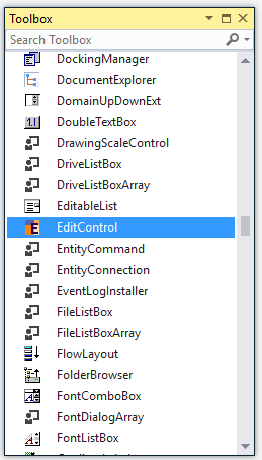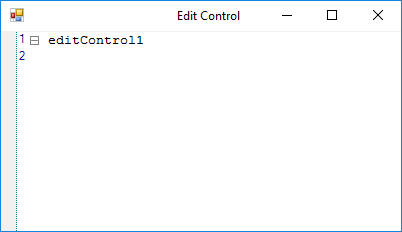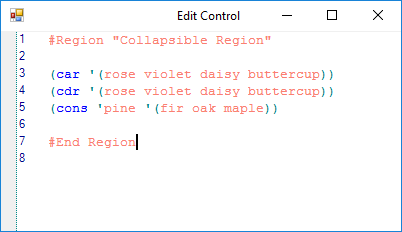Getting Started with Windows Forms Syntax Editor
2 Nov 20226 minutes to read
This section explains how to create an interactive code editor application like Microsoft Visual Studio Editor by using the EditControl.
Assembly deployment
Refer to the Control Dependencies section to get the list of assemblies or details of NuGet package that needs to be added as reference to use the control in any application.
Refer to NuGet Packages to learn how to install nuget packages in a Windows Forms application.
Adding EditControl via designer
-
Create a new Windows Forms project in Visual Studio.
-
Add the EditControl to an application by dragging it from the toolbox to a designer view. The following dependent assemblies will be added automatically:
- Syncfusion.Shared.Base
- Syncfusion.Tools.Windows
- Syncfusion.Edit.Windows

Adding EditControl via code
To add the control manually in C#, follow the given steps:
-
Create a C# or VB application via Visual Studio.
-
Add the following assembly references to the project:
- Syncfusion.Shared.Base
- Syncfusion.Tools.Windows
- Syncfusion.Edit.Windows
-
Create an instance of the EditControl, and then add it to the form.
// Create the EditControl instance. private Syncfusion.Windows.Forms.Edit.EditControl editControl1; editControl1 = new Syncfusion.Windows.Forms.Edit.EditControl(); // Set an appropriate size for the EditControl. editControl1.Size = new Size(50, 50); // Set the Dock property to the appropriate DockStyle enumeration value if desired. editControl1.Dock = DockStyle.Fill; // Set an appropriate BorderStyle to the EditControl instance. editControl1.BorderStyle = BorderStyle.Fixed3D; // Adding the edit control to the form. this.Controls.Add(editControl1);'Create the EditControl instance. private editControl1 As Syncfusion.Windows.Forms.Edit.EditControl editControl1 = New Syncfusion.Windows.Forms.Edit.EditControl() 'Set an appropriate size for the EditControl. editControl1.Size = New Size(50, 50) ' Set the Dock property to the appropriate DockStyle enumeration value if desired. editControl1.Dock = DockStyle.Fill 'Set an appropriate BorderStyle to the EditControl instance. editControl1.BorderStyle = BorderStyle.Fixed3D ' Adding the edit control to the form. Me.Controls.Add(editControl1)

Loading a file into document
This option helps to load a file into the EditControl.
// Loading the files into edit control by passing the file name as parameter to the LoadFile function.
this.editControl1.LoadFile(Path.GetDirectoryName(Application.ExecutablePath) + @"\..\..\FileName.cs");` Loading the files into edit control by passing the file name as parameter to the LoadFile function.
Me.editControl1.LoadFile(Path.GetDirectoryName(Application.ExecutablePath) + @"\..\..\FileName.cs")Syntax highlighting
The EditControl offers mostly-used languages such as C#, VB, XML, HTML, JScript, PowerShell, and SQL as built-in languages. It also provides support to configure a new custom language.
The EditControl has built-in syntax highlighting support for the following languages:
- C#
- VB.NET
- XML
- HTML
- Java
- SQL
- PowerShell
- C
- JavaScript
- VBScript
- Delphi
// Considering configuration settings for C# as an example. Using the [KnownLanguages](https://help.syncfusion.com/cr/windowsforms/Syncfusion.Windows.Forms.Edit.Enums.KnownLanguages.html) enumerator.
this.editControl1.ApplyConfiguration(KnownLanguages.CSharp);' Considering configuration settings for C# as an example. Using the [KnownLanguages](https://help.syncfusion.com/cr/windowsforms/Syncfusion.Windows.Forms.Edit.Enums.KnownLanguages.html) enumerator.
Me.editControl1.ApplyConfiguration(KnownLanguages.CSharp)
Custom language configuration
The EditControl provides supports custom language configuration. You can plug-in an external configuration file that defines a custom language to the EditControl using the Configurator.Open and ApplyConfiguration functions.
-
Create a configuration file.
- XAML
-
Apply the configuration file into the EditControl.
private string configFile = Path.GetDirectoryName(Application.ExecutablePath) + @"\..\..\config.xml"; // Plug-in an external configuration file. this.editControl1.Configurator.Open(configFile); // Apply the configuration defined in the configuration file. this.editControl1.ApplyConfiguration("LISP");private string configFile = Path.GetDirectoryName(Application.ExecutablePath) + @"\..\..\config.xml"; ' Plug-in an external configuration file. Me.editControl1.Configurator.Open(configFile) ' Apply the configuration defined in the configuration file. Me.editControl1.ApplyConfiguration("LISP")
<?xml version="1.0" encoding="utf-8" ?>
<ArrayOfConfigLanguage>
<ConfigLanguage name="LISP">
<formats>
<format name="Text" Font="Courier New, 10pt" FontColor="Salmon" />
<format name="KeyWord" Font="Courier New, 10pt" FontColor="Blue" />
<format name="String" Font="Courier New, 10pt, style=Bold" FontColor="Red" />
<format name="Operator" Font="Courier New, 10pt" FontColor="DarkCyan" />
</formats>
<extensions>
<extension>lsp</extension>
</extensions>
<lexems>
<lexem BeginBlock="(" Type="Operator" />
<lexem BeginBlock=")" Type="Operator" />
<lexem BeginBlock="'" Type="Operator" />
<lexem BeginBlock="car" Type="KeyWord" />
<lexem BeginBlock="cdr" Type="KeyWord" />
<lexem BeginBlock="cons" Type="KeyWord" />
</lexems>
<splits>
<split>#Region</split>
<split>#End Region</split>
</splits>
</ConfigLanguage>
</ArrayOfConfigLanguage>
NOTE
You can refer to our WinForms Syntax Editor feature tour page for its unique feature sets. You can also explore our WinForms Syntax Editor example that shows how to create interactive code editor applications with syntax highlighting, text indentation, intellisense, etc,.